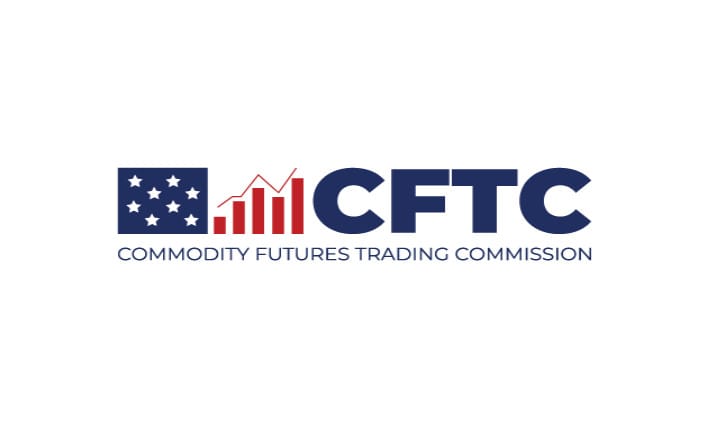NSCC APPROVES Enhancements to the Gap Risk Measure & the VaR Charge. "should help NSCC better protect against more idiosyncratic risk scenarios in concentrated portfolios than the current methodology"
"Idiosyncratic" used 12 times...
on characteristics that indicate that such ETFs are more or less prone to the effects of gap risk events, thereby providing more accurate coverage of the potential exposure arising from such positions.
Wut Mean?:
- NSCC handles clearing, settlement, risk management, and guarantees completion for almost all broker-to-broker trades in U.S. markets, covering equity securities, corporate and municipal debt securities, and unit investment trust transactions.
- To manage its credit risk with members, NSCC collects a suitable amount of margin (collateral) from each member.
NSCC's Current Margin Methodology:
- NSCC's margin system is set up to counter potential losses in case a member defaults by liquidating that member's portfolio.
- The collective margin deposits from all members form the NSCC's clearing fund. If a defaulting member's margin isn't enough to cover liquidation losses, this clearing fund is accessed.
- NSCC checks each member’s margin daily by simulating liquidation gains/losses using real unsettled positions and historical returns for each security.
- If liquidation losses exceed a member's margin, it's considered a backtesting deficiency. NSCC investigates recurring deficiencies, especially if they fall below a 99% confidence level.
- Members' margins have various components addressing specific NSCC risks. These are calculated overnight based on prior day's unsettled positions. Members are informed in the morning and need to make deposits by 10:00 a.m. EST.
- The largest part of a member's margin is the "volatility component", estimating potential portfolio losses within a 99th percentile confidence level.
- The method to compute this volatility depends on the security type and its trading history. For many securities like equities, NSCC uses a Value at Risk (VaR) model to determine this volatility, known as the "VaR Charge". This charge often makes up the most substantial part of a member's fund deposit.
Current Treatment of Gap Risk in NSCC’s Margin Methodology:
- NSCC uses a VaR Charge that considers gap risk. It only becomes the VaR Charge if it's the most significant of three potential calculations.
- Gap risk refers to sudden and significant price shifts due to unique issuer events like earning reports or management changes. The gap risk charge is for portfolios particularly vulnerable to these events, especially those where a single position makes up a significant part of the portfolio's value.
- A member gets a gap risk charge if their largest non-index net unsettled position surpasses a set percentage of their entire portfolio, termed the “concentration threshold”. It's capped at 30% but currently stands at 5%.
- The gap risk charge is only for non-index positions, essentially those positions outside of diversified index-tracking ETFs, since they are seen as less exposed to gap risk events.
- To compute this charge, NSCC multiplies the market value of the most significant non-index unsettled position by a predetermined "gap risk haircut". The minimum for this haircut is 10%. The exact percentage for this haircut is determined by looking at the extreme 1st and 99th percentile three-day returns for specific securities over a long look-back and stress period. The resulting percentage is then applied to the major non-index position to get the gap risk charge.
How it is changing:
Wut Mean?:
- The gap risk charge will now be added to a member's total VaR Charge whenever it applies. Previously, it only replaced the VaR Charge when it was the largest of three calculations. This addition improves the ability to handle unique risks.
- The gap risk charge will now consider the two largest positions in a portfolio instead of just the single largest one. This means the charge could apply when the combined value of these two largest positions exceeds a certain concentration threshold. This change offers better coverage for potential concurrent gap events in two major positions.
- The way the gap risk haircut (a percentage reduction) is determined will be revised. The minimum haircut for the largest position will be reduced from 10% to 5%, and a new minimum of 2.5% will be set for the second-largest position. This change in methodology is to ensure an appropriate margin level.
- NSCC will modify the criteria for ETF positions that are excluded from the gap risk charge. Instead of just excluding "non-index" positions, NSCC will exclude "non-diversified" positions, factoring in characteristics like the nature of the index the ETF tracks or whether the ETF is unleveraged. This change aims to be more precise about which ETFs are prone to gap risk and should improve transparency for members.
- regarding the gap risk charge for securities financing transactions cleared by NSCC, the methodology of which already includes the gap risk charge as an additive component to margin and which would not change as a result of this proposal, (ii) to make clear that the gap risk charge applies to Net Unsettled Positions, (iii) to remove an unnecessary reference, (iv) to reflect that NSCC considers impact analysis when determining and calibrating the concentration threshold and gap risk haircuts, and (v) to make other technical changes for clarity).
Why is it changing? It's all about the idiosyncratic risk!:
- NSCC's proposed changes approved for the gap risk charge, ensuring the collection of adequate margin to address risks from members’ portfolios.
- Based on provided confidential data and impact study, the changes offer better margin coverage than the current methodology.
- Making the gap risk charge additive should help NSCC address more idiosyncratic risk scenarios in concentrated portfolios compared to the existing methodology.
- Adjusting the gap risk calculation for the two largest positions with two separate haircuts, based on backtesting and impact analysis, allows NSCC to cover risks from simultaneous gap moves in multiple concentrated positions.
- Changing criteria for ETFs in the gap risk charge (from non-index to non-diversified) enhances NSCC's precision in determining which ETFs are susceptible to gap risk events, improving risk exposure accuracy.
- The Proposed Rule Change equips NSCC to better manage its exposure to portfolios with identified concentration risk, hence limiting its risk exposure during member defaults.
- NSCC's proposal ensures uninterrupted operation in its critical clearance and settlement services, even during a member default, by having adequate financial resources.
- The changes minimize the chance of NSCC tapping into the mutualized clearing fund, thereby reducing non-defaulting members' risk exposure to shared losses.
- The Commission believes these proposed changes will help NSCC safeguard securities and funds in its custody or control, aligning with Section 17A(b)(3)(F) of the Act.
The proposal aims to address the potential increased idiosyncratic risks NSCC might face, especially regarding the liquidation of a risky portfolio during a member default.
- After reviewing NSCC’s analysis, the Commission agrees that the proposal would result in improved backtesting coverage, reducing credit exposure to members.
- The Commission asserts that this proposal will empower NSCC to manage its credit risks more effectively, allowing it to adapt to backtesting performance issues, market events, structural changes, or model validation findings.
- This proactive management ensures NSCC can consistently collect enough margin to cover potential exposures to its members.
- The goal is to produce margin levels that align with the risk attributes of these concentrated holdings, especially securities more vulnerable to gap risk events.
- The proposal would enhance NSCC's ability to recognize and produce margins that match the idiosyncratic risks and attributes of portfolios that meet the concentration threshold.
- Broadening the gap risk charge to an additive feature and focusing on the two largest non-diversified positions will help NSCC better manage the idiosyncratic risks tied to concentrated portfolios.
- Given the additive nature of the gap risk charge, the Commission agrees that the adjustments to its calculation, like establishing floors for gap risk haircuts for the two largest positions, are aptly designed to handle NSCC’s idiosyncratic risks exposure during member defaults.
- Introducing specific criteria to determine which securities fall under the gap risk charge will enable NSCC to pinpoint those more prone to idiosyncratic risks, ensuring ETFs identified as non-diversified are included.
idiosyncratic said 12 times in the doc!
Previous Post:
TLDRS:
- Idiosyncratic said 12 times in the approval!
NSCC APPROVES Enhancements to the Gap Risk Measure and the VaR Charge.
- "NSCC believes that making the gap risk charge an additive component should help NSCC better protect against more idiosyncratic risk scenarios in concentrated portfolios than the current methodology"
- The gap risk charge will now be added to a member's total VaR Charge whenever it applies. Previously, it only replaced the VaR Charge when it was the largest of three calculations. This addition improves the ability to handle unique risks.
- The gap risk charge will now consider the two largest positions in a portfolio instead of just the single largest one. This means the charge could apply when the combined value of these two largest positions exceeds a certain concentration threshold. This change offers better coverage for potential concurrent gap events in two major positions.
- The way the gap risk haircut (a percentage reduction) is determined will be revised. The minimum haircut for the largest position will be reduced from 10% to 5%, and a new minimum of 2.5% will be set for the second-largest position. This change in methodology is to ensure an appropriate margin level.
- NSCC will modify the criteria for ETF positions that are excluded from the gap risk charge. Instead of just excluding "non-index" positions, NSCC will exclude "non-diversified" positions, factoring in characteristics like the nature of the index the ETF tracks or whether the ETF is unleveraged. This change aims to be more precise about which ETFs are prone to gap risk and should improve transparency for members.
- Adjusting the gap risk calculation for the two largest positions with two separate haircuts, based on backtesting and impact analysis, allows NSCC to cover risks from simultaneous gap moves in multiple concentrated positions.
The proposal aims to address the potential increased idiosyncratic risks NSCC might face, especially regarding the liquidation of a risky portfolio during a member default.
- After reviewing NSCC’s analysis, the Commission agrees that the proposal would result in improved backtesting coverage, reducing credit exposure to members.
- The proposal would enhance NSCC's ability to recognize and produce margins that match the idiosyncratic risks and attributes of portfolios that meet the concentration threshold.
- Broadening the gap risk charge to an additive feature and focusing on the two largest non-diversified positions will help NSCC better manage the idiosyncratic risks tied to concentrated portfolios.
- Given the additive nature of the gap risk charge, the Commission agrees that the adjustments to its calculation, like establishing floors for gap risk haircuts for the two largest positions, are aptly designed to handle NSCC’s idiosyncratic risks exposure during member defaults.
- Introducing specific criteria to determine which securities fall under the gap risk charge will enable NSCC to pinpoint those more prone to idiosyncratic risks, ensuring ETFs identified as non-diversified are included.
- They sure do seem concerned about idiosyncratic risk!...



